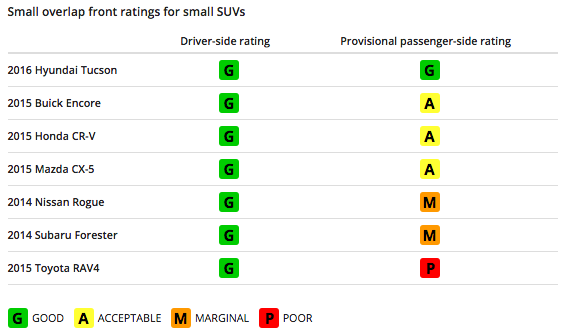Six out of seven small SUVs fail new safety test

The Insurance Institute for Highway Safey (IIHS) has released the results of a new study that demonstrate that, while automakers have achieved great success in protecting drivers in crashes, they have to some work to do when it comes to saving passengers. In fact, of the seven SUVs tested for passenger-side "small overlap" collisions, only one received a "good" rating, while the others ranged from "poor" to "adequate."
The small overlap test is already common practice for driver-side collisions. Also (or more commonly) known as the offset head-on crash, this is what happens when, for example, two vehicles crash with only the left sides coming into contact with each other, or when a vehicle strikes a pole or a tree. The study explains,
IIHS introduced the small overlap test in 2012, following the success of the moderate overlap front test in spurring automakers to make improvements. While the moderate overlap test involves 40 percent of the width of the vehicle, the small overlap test involves just 25 percent. It is designed to replicate what happens when the front corner of a vehicle collides with another vehicle or an object like a tree or utility pole.
Small overlap crashes pose a challenge because they bypass a typical vehicle's main front structure. Since the test was introduced, 13 manufacturers have made structural changes to 97 vehicles. Of these, nearly three-quarters earned a good rating after the changes.
The sole "good" performer of the new passenger-side test was the 2016 Hyundai Tucson. The worst perfomer was the 2014 Toyata RAV4, earning a "poor," followed by the 2014 Nissan Rogue and 2014 Subaru Forester, which dazzled with "marginal" ratings. The 2015 Mazda CX-5, 2015 Honda CR-V, and 2015 Buick Encore were all rated "adequate."
The IIHS says that more than 1,600 right-front passengers died in frontal crashes in 2014, so adding the passenger-side small overlap test to overall safety criteria would add a significant dimension to the safety information available for vehicles. Given the results of the new test, the IIHS is heavily considering doing just that. If they do, automakers will need to make some changes if they don't want to see a major dip in their safety ratings.


Comments
Safety Test on Vehicles
If you can not get out of the vehicle to look at what you've hit, then the vehicle FAILS the safety test. Your vehicles after an accident should still be pretty much in tact. If not then the car makers are the fault of our lack of safety. Period! It's not about insurance, auto medical or otherwise, it's about sustaining life and stopping injury in the first place.
Subaru Forester
Incorrect Data
Good to hear - I always liked the Forester and was believing what they put up here until I saw your post, thanks for clearing that up! C'mon ADC, verify your info is correct before posting
Thanks for your comment, Don.
Thanks for your comment, Don. The IIHS information this article refers to was releasted in 2016, and it tested the 2014 Forester, which received a "Marginal" rating, per the table above. Your link, also from the IIHS, is from 2013, so perhaps they tweaked their test or the Forester underwent another redesign. Jane, ADC staff
Information comes directly from the IIHS
Hi all, thanks for your concerns that ADC is publishing incorrect information. Since our information came directly from the Insurance Institute for Highway Safety, I guess we'll need to get in touch with them to find out if they feel their information is incorrect. We've always found this organization is highly ethical and will continue to trust their data, and publish it here. Ingrid, Accident Data Center
Information
Hard to tell sometimes and hard to check facts - you're right that you have to trust sources until told otherwise, sad thing is that it trickles down to where a recipient is now passing along false info and trust in them as a source is erroded. Y'all generally have the correct info and if you find conflicting info you update accordingly, I think most readers realize you're doing your best
Hi JB, thanks for your
Hi JB, thanks for your comment. I wrote this article, and it references a test done in 2016 on the 2014 Forester, whereas the link in the comment above (regarding the Forester's "acing" a test) is from 2013. Both sources are from the IIHS, a very good source, but the latest information from them on the Forester is that discussed in this article. I'm always happy to make corrections, but I believe we have the best info available in this instance. Jane, ADC
Add new comment